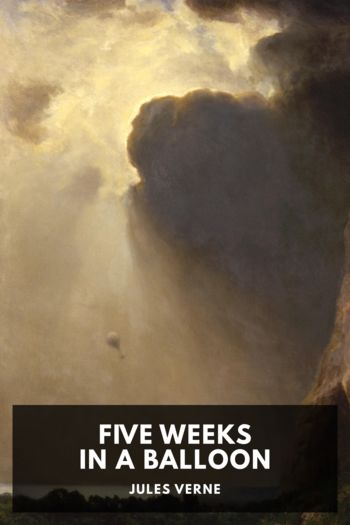Five Weeks in a Balloon, Jules Verne [best interesting books to read TXT] 📗

- Author: Jules Verne
Book online «Five Weeks in a Balloon, Jules Verne [best interesting books to read TXT] 📗». Author Jules Verne
Moreover, in case of an accident happening to the outside balloon, such as getting torn, for instance, the other would remain intact.
The balloons were made of a strong but light Lyons silk, coated with gutta percha. This gummy, resinous substance is absolutely waterproof, and also resists acids and gas perfectly. The silk was doubled, at the upper extremity of the oval, where most of the strain would come.
Such an envelope as this could retain the inflating fluid for any length of time. It weighed half a pound per nine square feet. Hence the surface of the outside balloon being about eleven thousand six hundred square feet, its envelope weighed six hundred and fifty pounds. The envelope of the second or inner balloon, having nine thousand two hundred square feet of surface, weighed only about five hundred and ten pounds, or say eleven hundred and sixty pounds for both.
The network that supported the car was made of very strong hempen cord, and the two valves were the object of the most minute and careful attention, as the rudder of a ship would be.
The car, which was of a circular form and fifteen feet in diameter, was made of wickerwork, strengthened with a slight covering of iron, and protected below by a system of elastic springs, to deaden the shock of collision. Its weight, along with that of the network, did not exceed two hundred and fifty pounds.
In addition to the above, the doctor caused to be constructed two sheet-iron chests two lines in thickness. These were connected by means of pipes furnished with stopcocks. He joined to these a spiral, two inches in diameter, which terminated in two branch pieces of unequal length, the longer of which, however, was twenty-five feet in height and the shorter only fifteen feet.
These sheet-iron chests were embedded in the car in such a way as to take up the least possible amount of space. The spiral, which was not to be adjusted until some future moment, was packed up, separately, along with a very strong Buntzen electric battery. This apparatus had been so ingeniously combined that it did not weigh more than seven hundred pounds, even including twenty-five gallons of water in another receptacle.
The instruments provided for the journey consisted of two barometers, two thermometers, two compasses, a sextant, two chronometers, an artificial horizon, and an altazimuth, to throw out the height of distant and inaccessible objects.
The Greenwich Observatory had placed itself at the doctor’s disposal. The latter, however, did not intend to make experiments in physics; he merely wanted to be able to know in what direction he was passing, and to determine the position of the principal rivers, mountains, and towns.
He also provided himself with three thoroughly tested iron anchors, and a light but strong silk ladder fifty feet in length.
He at the same time carefully weighed his stores of provision, which consisted of tea, coffee, biscuit, salted meat, and pemmican, a preparation which comprises many nutritive elements in a small space. Besides a sufficient stock of pure brandy, he arranged two water-tanks, each of which contained twenty-two gallons.
The consumption of these articles would necessarily, little by little, diminish the weight to be sustained, for it must be remembered that the equilibrium of a balloon floating in the atmosphere is extremely sensitive. The loss of an almost insignificant weight suffices to produce a very noticeable displacement.
Nor did the doctor forget an awning to shelter the car, nor the coverings and blankets that were to be the bedding of the journey, nor some fowling pieces and rifles, with their requisite supply of powder and ball.
Here is the summing up of his various items, and their weight, as he computed it:
Ferguson 135 pounds Kennedy 153 ” Joe 120 ” Weight of the outside balloon 650 ” Weight of the second balloon 510 ” Car and network 280 ” Anchors, instruments, awnings, and sundry utensils, guns, coverings, etc. 190 ” Meat, pemmican, biscuits, tea, coffee, brandy 386 ” Water 400 ” Apparatus 700 ” Weight of the hydrogen 276 ” Ballast 200 ” 4,000 poundsSuch were the items of the four thousand pounds that Dr. Ferguson proposed to carry up with him. He took only two hundred pounds of ballast for “unforeseen emergencies,” as he remarked, since otherwise he did not expect to use any, thanks to the peculiarity of his apparatus.
VIIIJoe’s importance—The commander of the Resolute—Kennedy’s arsenal—Mutual amenities—The farewell dinner—Departure on the 21st of February—The doctor’s scientific sessions—Duveyrier—Livingstone—Details of the aerial voyage—Kennedy silenced.
About the 10th of February, the preparations were pretty well completed; and the balloons, firmly secured, one within the other, were altogether finished. They had been subjected to a powerful pneumatic pressure in all parts, and the test gave excellent evidence of their solidity and of the care applied in their construction.
Joe hardly knew what he was about, with delight. He trotted incessantly to and fro between his home in Greek Street, and the Mitchell establishment, always full of business, but always in the highest spirits, giving details of the affair to people who did not even ask him, so proud was he, above all things, of being permitted to accompany his master. I have even a shrewd suspicion that what with showing the balloon, explaining the plans and views of the doctor, giving folks a glimpse of the latter, through a half-opened window, or pointing him out as he passed along the streets, the clever scamp earned a few half-crowns, but we must not find fault with him for that. He had as much right as anybody else to speculate upon the admiration and curiosity of his contemporaries.
On the 16th of February, the Resolute cast anchor near Greenwich. She was a screw propeller of eight hundred tons, a fast sailer, and the very vessel that had been sent out to the polar regions, to revictual the last expedition of Sir James Ross. Her commander, Captain Bennet, had the name of being a very amiable person, and he took a particular interest in the doctor’s expedition, having been one of that gentleman’s admirers for a long time. Bennet was





Comments (0)